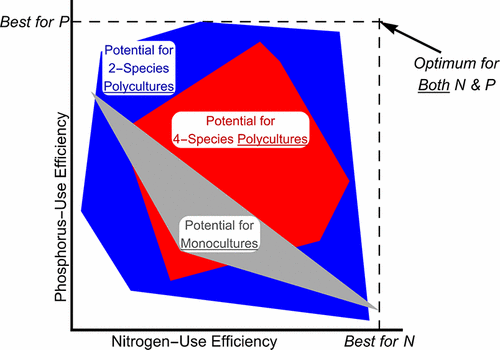当前位置:
X-MOL 学术
›
Environ. Sci. Technol.
›
论文详情
Our official English website, www.x-mol.net, welcomes your
feedback! (Note: you will need to create a separate account there.)
Ecological Stoichiometry Meets Ecological Engineering: Using Polycultures to Enhance the Multifunctionality of Algal Biocrude Systems
Environmental Science & Technology ( IF 10.8 ) Pub Date : 2017-09-11 00:00:00 , DOI: 10.1021/acs.est.7b02137 Casey M. Godwin 1 , David C. Hietala 2 , Aubrey R. Lashaway 1 , Anita Narwani 3 , Phillip E. Savage 2, 4 , Bradley J. Cardinale 1
Environmental Science & Technology ( IF 10.8 ) Pub Date : 2017-09-11 00:00:00 , DOI: 10.1021/acs.est.7b02137 Casey M. Godwin 1 , David C. Hietala 2 , Aubrey R. Lashaway 1 , Anita Narwani 3 , Phillip E. Savage 2, 4 , Bradley J. Cardinale 1
Affiliation

|
For algal biofuels to be economically sustainable and avoid exacerbating nutrient pollution, algal cultivation and processing must maximize rates of biofuel production while simultaneously minimizing the consumption of nitrogen (N) and phosphorus (P) fertilizers. We experimentally tested whether algal polycultures could be engineered to improve N and P nutrient-use efficiency compared to monocultures by balancing trade-offs in nutrient-use efficiency and biocrude production. We analyzed the flows of N and P through the processes of cultivation, biocrude production through hydrothermal liquefaction, and nutrient recycling in a laboratory-scale system. None of the six species we examined exhibited high N efficiency, P efficiency, and biocrude production simultaneously; each had poor performance in at least one function (i.e., <25th percentile). Polycultures of two to six species did not outperform the best species in any single function, but some polycultures exhibited more balanced performance and maintained all three functions at higher levels simultaneously than any of the monocultures (i.e., >67th percentile). Moreover, certain polycultures came closer to optimizing all three functions than any of the monocultures. By balancing trade-offs between N and P efficiency and biocrude production, polycultures could be used to simultaneously reduce the demand for both N and P fertilizers by up to 85%.
中文翻译:

生态化学计量学与生态工程学相遇:利用多元文化提高藻类生物粗制系统的多功能性
为了使藻类生物燃料在经济上可持续发展并避免加剧营养污染,藻类种植和加工必须使生物燃料的生产率最大化,同时使氮(N)和磷(P)肥料的消耗量最小化。我们通过实验测试了藻类混合培养物是否可以通过平衡养分利用效率和生物原油生产之间的权衡而设计成与单培养相比提高氮和磷养分利用效率。我们在实验室规模的系统中分析了通过种植,通过水热液化生产生物粗品和营养物质循环过程中氮和磷的流动。我们研究的六个物种中没有一个同时显示出高氮效率,磷效率和生物粗品产量。每一个在至少一项功能上的表现都很差(即<25%)。两到六个物种的混养在任何一项功能上都没有表现出最好的物种,但是某些混养表现出比任何单一培养都更平衡的性能,并同时将所有三个功能保持在更高的水平(即,> 67%)。而且,某些多元文化比任何单一文化更接近于优化所有三个功能。通过在氮和磷效率与生物原油生产之间权衡取舍,可以使用混养将氮和磷肥料的需求同时减少多达85%。某些多元文化比任何单一文化更接近于优化所有三个功能。通过在氮和磷效率与生物原油生产之间权衡取舍,可以使用混养将氮和磷肥料的需求同时减少多达85%。某些多元文化比任何单一文化更接近于优化所有三个功能。通过在氮和磷效率与生物原油生产之间权衡取舍,可以使用混养将氮和磷肥料的需求同时减少多达85%。
更新日期:2017-09-11
中文翻译:

生态化学计量学与生态工程学相遇:利用多元文化提高藻类生物粗制系统的多功能性
为了使藻类生物燃料在经济上可持续发展并避免加剧营养污染,藻类种植和加工必须使生物燃料的生产率最大化,同时使氮(N)和磷(P)肥料的消耗量最小化。我们通过实验测试了藻类混合培养物是否可以通过平衡养分利用效率和生物原油生产之间的权衡而设计成与单培养相比提高氮和磷养分利用效率。我们在实验室规模的系统中分析了通过种植,通过水热液化生产生物粗品和营养物质循环过程中氮和磷的流动。我们研究的六个物种中没有一个同时显示出高氮效率,磷效率和生物粗品产量。每一个在至少一项功能上的表现都很差(即<25%)。两到六个物种的混养在任何一项功能上都没有表现出最好的物种,但是某些混养表现出比任何单一培养都更平衡的性能,并同时将所有三个功能保持在更高的水平(即,> 67%)。而且,某些多元文化比任何单一文化更接近于优化所有三个功能。通过在氮和磷效率与生物原油生产之间权衡取舍,可以使用混养将氮和磷肥料的需求同时减少多达85%。某些多元文化比任何单一文化更接近于优化所有三个功能。通过在氮和磷效率与生物原油生产之间权衡取舍,可以使用混养将氮和磷肥料的需求同时减少多达85%。某些多元文化比任何单一文化更接近于优化所有三个功能。通过在氮和磷效率与生物原油生产之间权衡取舍,可以使用混养将氮和磷肥料的需求同时减少多达85%。











































 京公网安备 11010802027423号
京公网安备 11010802027423号